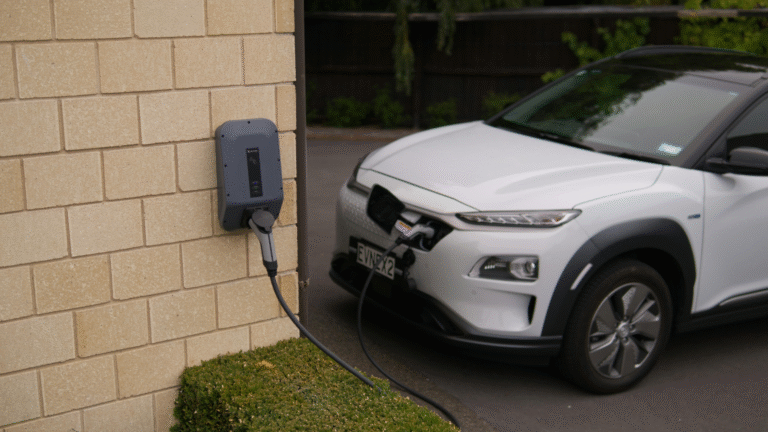Renting shouldn’t make EV ownership impossible — but renters (and landlords) face real hurdles installing reliable overnight charging. From landlord permissions and shared-meter complications to temporary installations and apartment body corporate rules, practical steps and clear communication make safe, legal overnight charging achievable. This guide explains how tenants can set up reliable overnight charging without risking tenancy or safety issues.
Table of Contents
- Why overnight charging is vital for EV renters
- Permissions and legal basics when renting or leasing
- Types of overnight charging solutions for rental homes
- Practical installation steps and electrician checklist
- Apartment-specific strategies: shared buildings and body corporates
- Best-practice habits for tenants and property managers
- FAQs
1. Why overnight charging is vital for EV renters
A reliable overnight charge replicates the convenience of a private driveway: lower-cost electricity, predictable SoC in the morning, and reduced reliance on public chargers. For tenants who can’t install permanent hardware easily, practical options still exist — if you know the right approach.
2. Permissions and legal basics when renting or leasing
- Talk to your landlord first. Explain the minimal invasiveness of a wallbox installation and present a reputable electrician’s quote.
- Offer to return the property to its original state at lease end if that helps get permission.
- Check insurance and safety obligations: some landlords want written confirmation from the installer. A licensed electrician and a compliant wallbox usually meet common-sense standards.
- Document everything: written permission avoids future disputes.
Clear communication and a low-disruption plan usually smooth approvals.
3. Types of overnight charging solutions for rental homes
- Portable EVSE on standard outlet: Cheap and non-invasive, but slow (overnight top-ups are often fine for short-range daily use).
- Dedicated plug-and-charge via a 15–32A outlet: A licensed electrician can install a dedicated outlet for faster charging with minimal intrusion.
- Full wallbox (hardwired or plug-in): Best reliability and safety; requires electrician work and landlord approval. Many modern wallboxes are plug-in and can be moved at lease end.
- Shared charge points: For multi-tenant houses, a single wallbox with a schedule or access control can work; cost-sharing arrangements are key.
Choose the option that balances speed, cost and landlord willingness.
4. Practical installation steps and electrician checklist
- Get three quotes where possible and ask electricians for references with rental installations.
- Ask for a safety compliance certificate and RCD / RCBO protection on the dedicated circuit.
- Check cable routing and mounting options to avoid damage to property.
- Confirm load capacity of the property’s consumer unit; larger chargers may need consumer-unit upgrades.
- Request an installation warranty and clear handover of operation instructions.
Good installers minimise property impact and provide neat, reversible work.
5. Apartment-specific strategies: shared buildings and body corporates
- Remote (shared) chargers in car parks: Propose a phased rollout to your body corporate with cost sharing; cite amenity improvements for all residents.
- Smart load sharing: Multi-tenant systems that schedule charging and distribute power avoid expensive meter upgrades.
- Leasehold parking spots: Negotiated cables or retractable posts can allow temporary charging with minimal communal impact.
- Apply for grants or council support: Some local governments offer incentives or co-funding for apartment charging.
Successful apartment projects combine clear rules, booking systems and fair cost allocation.
6. Best-practice habits for tenants and property managers
- Charge overnight and avoid peak demand windows.
- Maintain clear records of permission and work done.
- Share charger etiquette and schedules in shared drives to avoid disputes.
- Ensure chargers are regularly inspected and firmware updated where applicable.
These practical rules keep charging safe and relationships friendly.
FAQs
Q: Can landlords refuse wallbox installation?
A: They can say no, but many landlords accept well-documented, low-impact installations. Offer to pay and to remove the equipment at lease end if needed.
Q: Is a portable cable enough?
A: For low-mileage drivers, a portable EVSE on a dedicated outlet can be perfectly adequate and low-cost.
Q: What if the building refuses shared chargers?
A: Consider off-site overnight charging (workplace or nearby destination chargers) or negotiate pilot trials as proof-of-concept.
Conclusion
Reliable overnight charging in rental homes is eminently achievable with good communication, a practical installation plan and the right kit. Tenants should approach landlords with clear proposals, licensed electrician quotes and reversible solutions. In apartments, body corporate collaboration and smart load-sharing systems unlock charging for many residents. With goodwill and a pragmatic plan, overnight charging becomes a straightforward amenity — not a hassle.
Meta description: Renters can set up overnight EV charging safely and legally. Learn practical installation options, landlord permissions, and apartment strategies for reliable home charging.
